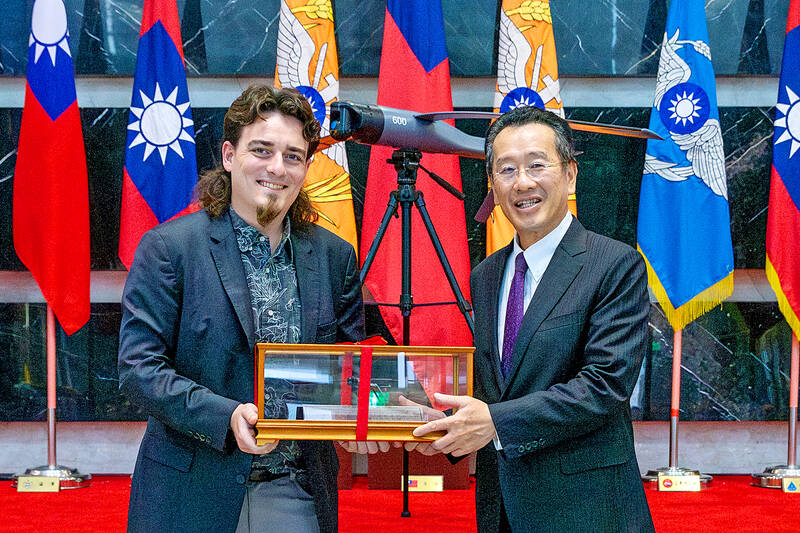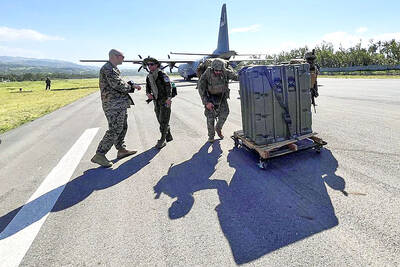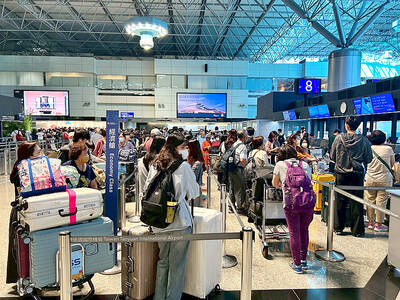The military is to buy up to 1,200 more attack drones from the US, following an assessment that its current inventory is insufficient, a source said yesterday.
Taiwan has already purchased 685 units of the Switchblade 300 loitering munitions drones from US defense contractor AeroVironment, as well as 291 units of the 600M-V anti-armor drones from contractor Altius, the shipments of which have begun arriving.
However, a recent Ministry of National Defense (MND) assessment showed that the number of attack drones is still insufficient, so another procurement phase has begun, the source said.

Photo courtesy of the Ministry of National Defense
The second phase, codenamed “Project Hunter Owl,” would potentially expand the program to include more powerful attack drones with longer ranges, the source said, adding that the military plans to purchase between 800 and 1,200 units from the US.
Minister of National Defense Wellington Koo (顧立雄) last month said that the military might seek to acquire the upgraded Altius-700 series, depending on joint force planning and fiscal conditions.
The ministry initially submitted an NT$11.536 billion (US$376.81 million) budget proposal to the Legislative Yuan for the project, which was reduced to NT$5.78 billion after factoring in Taiwan’s domestic contributions to the drone program, the source said.
The military initially intended to use the surplus to purchase more attack drones directly from the US, but lawmakers rejected the idea, insisting that the money first be returned to the treasury, they said.
“Therefore, the ministry submitted a new procurement proposal to purchase more drones,” they said.
Separately, the budget the ministry submitted to the legislature indicates that the air force would continue to commission the National Chungshan Institute of Science and Technology (NCSIST) to produce Wan Chien air-to-ground cruise missiles, following the conclusion of the Air and Sea Combat Power Improvement Program next year.
The NCSIST had been producing 10 designated weapons systems at a budget of NT$236.97 billion under a five-year program.
The air force has listed a “Wan Chien Missile System Commissioned Production” program worth NT$517.45 million, covering last year to 2028, the budget showed.
Some have speculated that the new program would focus on small-scale production of the Wan Chien II, which has an extended range of up to 400km.
The ministry declined to comment on the speculations.
As of last year, 150 Wan Chien missile systems were completed under the original program.
Production of the Chien Hsiang loitering munition (an anti-radiation uncrewed aerial vehicle) and the long-range Hsiung Sheng surface-to-surface missile system are set to be completed by the end of this year, and production of several other systems are scheduled to be completed by the end of next year.
Production is expected to be completed next year on a coastal defense anti-ship missile system, air defense systems employing Tien Chien II missiles and Tien Kung III surface-to-air missiles, high-performance naval vessels and Coast Guard Administration vessels equipped with weapons systems, the source said.
In related news, a source yesterday said that the army would showcase newly acquired US-made M1A2T Abrams tanks and High Mobility Artillery Rocket Systems (HIMARS) for the first time during the biennial Taipei defense show.
The Taipei Aerospace & Defense Technology Exhibition (TADTE) is to take place from Thursday next week to Saturday at the Taipei Nangang Exhibition Center’s Hall 1, and would feature a record 400 exhibitors from 14 countries, including the US, France and Germany, organizers said.
Taiwan’s military would, as usual, set up a pavilion at the event, in cooperation with the Armaments Bureau and the NCSIST.
The bureau would display four types of new drones it developed: first-person view drones, explosive drones, kamikaze or suicide drones and surveillance drones, the source said, adding that it would be the explosive’s and suicide drones’ TADTE debut.
The NCSIST would display its attack drone boat, they said.
Additional reporting by CNA

Three batches of banana sauce imported from the Philippines were intercepted at the border after they were found to contain the banned industrial dye Orange G, the Food and Drug Administration (FDA) said yesterday. From today through Sept. 2 next year, all seasoning sauces from the Philippines are to be subject to the FDA’s strictest border inspection, meaning 100 percent testing for illegal dyes before entry is allowed, it said in a statement. Orange G is an industrial coloring agent that is not permitted for food use in Taiwan or internationally, said Cheng Wei-chih (鄭維智), head of the FDA’s Northern Center for

The Chinese military has built landing bridge ships designed to expand its amphibious options for a potential assault on Taiwan, but their combat effectiveness is limited due to their high vulnerability, a defense expert said in an analysis published on Monday. Shen Ming-shih (沈明室), a research fellow at the Institute for National Defense and Security Research, said that the deployment of such vessels as part of the Chinese People’s Liberation Army (PLA) Navy’s East Sea Fleet signals a strong focus on Taiwan. However, the ships are highly vulnerable to precision strikes, which means they could be destroyed before they achieve their intended

LOOKING NORTH: The base would enhance the military’s awareness of activities in the Bashi Channel, which China Coast Guard ships have been frequenting, an expert said The Philippine Navy on Thursday last week inaugurated a forward operating base in the country’s northern most province of Batanes, which at 185km from Taiwan would be strategically important in a military conflict in the Taiwan Strait. The Philippine Daily Inquirer quoted Northern Luzon Command Commander Lieutenant General Fernyl Buca as saying that the base in Mahatao would bolster the country’s northern defenses and response capabilities. The base is also a response to the “irregular presence this month of armed” of China Coast Guard vessels frequenting the Bashi Channel in the Luzon Strait just south of Taiwan, the paper reported, citing a

About 4.2 million tourist arrivals were recorded in the first half of this year, a 10 percent increase from the same period last year, the Tourism Administration said yesterday. The growth continues to be consistent, with the fourth quarter of this year expected to be the peak in Taiwan, the agency said, adding that it plans to promote Taiwan overseas via partnerships and major events. From January to June, 9.14 million international departures were recorded from Taiwan, an 11 percent increase from the same period last year, with 3.3 million headed for Japan, 1.52 million for China and 832,962 to South Korea,